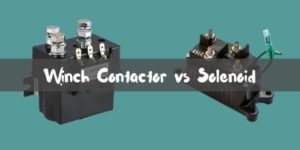Last Updated on June 21, 2021
It is very much possible that your winch may face failure issues. Either it can be for mechanical failure or electrical failure. There is nothing much to think about. However, if your winch faces the same issues, then there is a good possibility that the problem is in an electrical component.
Because the electric component of your winch is very much prone to failure. The electrical component can get corroded or wet. Any kind of small damage on the circuit of your winch can be the reason for your winch damage. The solenoid or contactor of a winch is the most vulnerable part that is electrical components. On the other hand, the mechanical parts of your winch are very much durable and rugged.
So, whenever your winch faces trouble with electrical, you will have to fix or replace them. Now the question is, which one I should opt for? A winch contactor or solenoid? What are the actual differences between them?
Basically, In this article, I will be discussing everything about the winch contactor and winch solenoid. If you are really looking for this piece of information, then stay with me and go through the article. You will get everything here.
Quick Navigation
Do I need to pay heed to this?
Well, now the question is do I really need to consider whether I should bring a winch contactor or solenoid? Is there any negative effect of using these two components? The answer is no. But, getting a solenoid for your truck winch will limit your winch capability.
Without it, using a solenoid will not be efficient as it will restrict 90% of the total current. However, with only this information you can’t decide which is the best for your winch. To determine which one is better, you need to know some other things like their roles and differences.
Contactors or Solenoids:
In general, both contactors and solenoids are the switches to on or off your winch. Apart from that, you will need to hotwire your winch in order to get it to turn on and even you will not be able to control your winch properly. You will find that your winch is just rotating its drum crazily which is not expected.
However, before going into the depth of these two, you need to have a clear idea about some things. You will have to know relay; which is another type of switch. Then, you will be able to get a clear idea about winch contactors and solenoids.
What is Relay?
Well, the relay is a widely used electro-mechanical switch. This type of switch is used in vehicles. The duty of a relay is to make the electrical current lower approximately 40 to 100amps for controlling an extremely-powered circuit. A relay also controls a few high-powered circuits using only one electrical signal. At the present time, most car owners go for relay switches for activating the vehicles fan motors, headlights, blower motors and auxiliary lamps.
Whatever a relay switch comes as a host of different designs from the electromagnetic relays to solid-state designs. The electromagnetic relay uses a magnet for allowing the current flow and the solid-state designs use it for allowing the electric currents with the help of semiconductors.
Here I am talking about several configurations of relay switches:
Mini ISO relays: This type of switch is used for general purposes. They come as a blueprint to the automotive industries. The Mini ISO relays are the most basic type and they can fit in a good number of vehicles’ electrical applications like starting, lighting, cooling, heating and horn.
Micro Relays: Micro relays are considered the standard and universal pattern for electrical terminals. Basically, this type of relay is a small plug-in design for the use of automotive industries. The Micro relays are very handy and it requires more than 35amps for switching.
Maxi Relays: The Maxi relays are almost the same as the previous-mentioned Mini Relays. It is an updated version of Mini Relays. The Maxi relays are the stronger version of Mini relays. They are considered in heavy-duty applications. Engine management, cooling fans, car alarms and fuel control are the ideal use of Maxi relays.
ISO 280 Mini, Ultra and Micro Relays: Well, this type of relay is highly exaggerated. Following an ISO 280 design and footprint pin, this type of relays is the small and compact edition of the standard relays. This type of relays is used in power distribution units and ATM fuse boxes.
What is actually a solenoid?
Basically, the solenoid is another relay-type switch. The difference is that the solenoid is designed specially to remotely switch heavier current that varies from 80 to 200-amps. Comparing with smaller electro-mechanical relays, this type of relay has a coil for generating a magnetic field whenever current flows. If so happens, then it closes or opens the circuit.
Talking about the winch solenoid, the working criteria is the same as solenoid also works as a switch. Solenoid plays an important role in supplying exact current to your winch. As a result, it prevents your winch motor from damage.
Whenever you will active your winch, the electricity flows to the solenoid from your winch battery and your winch turns on. Once the winch is activated, the electricity is shipped off the engine to start running your winch with the help of a solenoid. Generally, the normal winch is occupied with two isolated solenoids for reversing and forward.
Read Next:
What is actually a Contactor?
A contactor is the main relay switch to deal with an extremely current load which usually varies from 100 to 600-amps. The contactor has a good voltage rating for sustaining 12V DC up to 12000V DC. This type of switch is very cheap and also effective to use.
Some common applications including heavy-duty trucks and tools, hybrid/electric cars. emergency vehicles, transports, mining, light rail and some other frameworks that demand excessive current for a standard solenoid or relay.
Which one I should opt for? Contactor or solenoid?
Well, if you talk about the capabilities, then the contactors in the first position. The solenoids and relays are in the second and third positions accordingly. The contactor has the ability to handle heavy-duty jobs you don’t need them always though. Without it, the contactors are the expensive ones comparing with the other two options. In contrast, the solenoids are relays are inexpensive and also cheap.
Now, you have to determine which one you need. If you hold a heavy-duty winch, then you should go for a contactor. Otherwise, going for solenoid will be enough if your winch is not for heavy-duty.
However, before going for any option, at first, make sure that it will fit in its place.
Last words on Winch Contactor vs Solenoid
Actually, there is no winner. It all depends on your needs. Both the contactor and solenoid have almost similar characteristics except the heavy-duty handling feature.
In a word, contactor is the best option if you need a switch for holding raw power. Otherwise, a solenoid will be the best option if you need something just enough.


I’m Daniel Galbreath, founder of OffRoadersWorld.
I spend my spare time writing on this website, OffRoaders World. I share my thoughts and reviews on different types of gears, share tips sometimes. This website is specially created and regularly updated basically to help other folks like me when I started to solve the various problems they face, specially when they go off-roading.
